Film - Terry Gilliam's Shorts
Susan Omand goes exploring in Terry Gilliam’s shorts... wait, that doesn’t sound right...
I won't be getting an Academy Award - I'll predict that - ever. And somehow, my life will be no less for that!
If you’re a fan of Monty Python at all, you will have seen Terry Gilliam’s animation work, from the iconic title sequence with the foot descending on the show’s title, to the tiny “in between sketches” vignettes of utter WTF surrealism. Before he became a Python though, he had already become known for animation with his work on Do Not Adjust Your Set, with his preference for cut-out animation, which involves, as it implies, pushing cut out bits of paper, often from vintage photographs and illustrations, in front of a camera instead of photographing pre-drawn images, which allows for more spontaneous, if jerkier, movement and is comparatively cheaper and easier to do, which fit well with the TV budgets of the time. However he also did short films and animations outwith these shows and it is these that I want to concentrate on as there are six listed in the IMDb filmography of Terry Gilliam that I have managed to find and watch. The first three are animations, so I found some popcorn and sat down for a cinematic ... something, anyway.
Storytime
Story time is an eight minute cut out animation which starts with Don the cockroach who has fun being a cockroach, bouncing on bread, sliding down banana skins and generally doing noisy things in dark cupboards (which was a great way to get the character to play in your head without actually having to do the work onscreen) until he is squashed by Jeremy Trousercrease (well, that’s what it sounded like). After a circuitous explanation, about who Jeremy is and who he is connected to, we get back to Don the Cockroach, now alive and well again, due probably to x being equal to 0 in an equation somewhere, and the narrator gets beaten up for repeating himself and we’re on to the second cartoon in the set, The Albert Einstein Story. Albert is despised by his neighbours for being the only Albert Einstein who didn’t discover relativity and they make this known by randomly sticking their heads out of their mid terrace front doors whackamole style and booing at him. However, he was very good with his hands and they, in turn, were very good with him by not staying out late or going dancing without him. Allegedly one hand was even seen out with a foot which caused a scandal that hit the papers. Erm... oookaaay. The third part of storytime sees The Christmas Card being delivered in a huge envelope, which is opened to reveal various recognisable Christmassy scenes, so the camels chase the star, a skater cuts a hole in the ice which falls away, leaving him standing on a plinth, and a hunter shooting first the deer in a festive forest scene and then a giant robin, and so on. All very.... festive.
Storytime was initially shown in cinemas before the Monty Python film, Life of Brian, and the first two parts are typical Gilliam style, with a mix of hand drawn images and photographs used to surreal effect as heads are used as inkwells, bridal moustaches come to the fore and hands and feet tango on their own. The Christmas Card is slightly different, being all hand drawn in a sepia pen and ink style, although the staccato animation of the cut-outs is still very much in evidence. Is it funny? Not for me. Clever in writing and concept definitely but it doesn’t make me laugh. I guess the question is, was it meant to?
Watch Storytime HERE...
The Miracle of Flight
The Miracle of Flight is a 5 minute animated short done in the style of the Monty Python animations for which Gilliam is so famous, but never included in one of the films or episodes. Going from deep in the mists of time with a pastoral shepherd being mesmerised with the birds overhead, it charts man’s attempts at flight, first under his own steam and then assisted. Not quite as surreal as his other cartoons, this one had a lot of clever humour in it, and I actually laughed at the old lady feeding the birds. I also really enjoyed the fact that people tried everything from a round bird body suit, to large clawed feet to hammering their arms flat into wings in order to attain flight before science intervened and did the same thing over and over again, i.e. kicking people off the top of a mountain, in the hope that the result would change. Then “suddenly, 300 years later” someone invents the airline ticket (wonderfully for Spam-Am) and this produces a cascade of other inventions from the inflight movie to the terminal building and the passenger gets the inevitable result... I enjoyed this a lot more than the first one, I think because there is a logical progression to it. It is linguistically clever and brilliantly animated but leaving the complete wtf, unexplained surrealism that Gilliam does so much, really helped. Indeed this film was award nominated so it can’t be just me.
Watch The Miracle of Flight HERE...
Beware of the Elephants
This is three and a half minutes of black and white cut out animation that starts with a man looking at a sign that says Beware of the Elephants (hence the name I suppose). Without warning, an elephant falls from the sky and knocks his head off which becomes a football in a game, during which all the players heads fly off into a chattering mass that, examined under a magnifying glass becomes the “active ingredient” in an advert for washing powder. *breathes* From washing sheets to Washington and a city is destroyed by cannon fire and everything is drenched in washing powder from the hole in the scenery, which a coach and horse rides over, before it is held up by a highwayman. *breathes* The protagonist is lined up against a wall to be shot but escapes with a fire engine after the page burns away revealing *breathes* cupid who also shoots at a man on a bench who proposes to the lady beside him as cupid flies away to be flicked off a cloud by god’s finger as *breathes* as a balloon floats up in the shape of Harold Wilson’s head which is buzzed by Superman, dragging a banner about buying bonds which is shot out of the sky by a ballistic finger but he drops a bomb on a city which turns into amushroom cloud, then a mushroom which is looked at by a man who then walks past the sign saying Beware of the Elephants.... Phew.
Not really a lot I can add to that. Suitably surreal and well rounded, literally in the case of the circular narrative.
Watch Beware of the Elephants HERE...
The rest of the short films are all live action rather than animation and slightly longer at between 15 and 20 minutes each, so I replenished my popcorn and settled in for a more sustained viewing.
The Wholly Family
The Wholly family is a short film by Gilliam from 2012 about a family visitng Naples. The young boy, Jake, wants to buy a Punchinello ornament but his Napoli mother refuses and his father explains that, really, if you buy one you have to give it as a gift to someone else and not keep it otherwise it’s bad luck, which the stall holder overhears. The family walks to another square where the father explains to Jake it’s where he met Jake’s mother. While his parents argue over the location , Jake wanders off again and back to where the ornaments are. The stall holder shows Jake some of the other ornaments including a nativity based in a kitchen but Jake’s parents show up and drag him away again, arguing over how he should be controlled. The stall holder lifts up an empty plinth, as somebody has taken one of the ornaments with them... Jake is taken back to the hotel and sent to bed without supper, where he finds the ornament in his pocket which he stands beside the bed. He wakes in the middle of the night hungry and the ornament comes to life, ingesting the boy and a whole line of Punchinello type clowns present him with plate after plate of food, ending with his parent’s heads on platters, before carrying him off “for a history lesson” over a bridge to a white house and show him a couple dancing through the window. It’s his parents wedding and they are happy. Jake wakes up in what looks like a hospital ward, populated by the clowns all carrying big eggs. He sees his parents getting a broken egg with a baby in. They have started arguing. His mother drops the baby on the floor and it breaks like a doll. Taken to the doll mender by one of the clowns, the mender says it’s not worth fixing and the clown drops the doll, Jake, into the fire. Jakes wakes up in his own bed, saying he will be good, and discovers it was a nightmare. He realises he was causing the arguments between his parents and brings them breakfast in bed, yes eggs, to make up for it, with the good luck ornament on the trolley. As the film ends, the camera pulls back to show the family scene is one of the ornaments being displayed by the stall holder.
A suitable morality tale where the boy learns his lesson but why does it always have to be scary clown types?! It actually helped my enjoyment that this was in Italian and subtitled as it added to the surrealism of the tale, being, to me, an unknown language which made me concentrate on the imagery of the nightmare scenes. And because the majority of the “oddness” one expects from a Gilliam film was contained within that dream sequence it made a lot more logical sense to me.
Watch The Wholly Family HERE...
The Crimson Permanent Assurance
This short film was initially released as a featurette to be shown alongside the cinema release of Monty Python’s Meaning of Life in 1983 . So, obviously, we go back to 1983 and London for the start of this short film where the Permanent Assurance, an accounts firm staffed by elderly workers has been taken over by the Very Big Corporation of America. When the management sack an employee, there's an uprising and the elderly staff overthrow the management, to the point of self-defenestration in a couple of cases, with the rest being locked in the safe, and the building is unleashed from its moorings and the sails hoisted, after a cuppa, by the pirates...er... accountants climbing the rigging...er...scaffolding with their cutlasses...er... pens between their teeth. The Crimson Permanent Assurance sets sail through the streets with the scaffolding sheets billowing and a skull and crossbones on its financial graph as they head for the financial district. They sneak in among the skyscrapers, steering through the streets, firing filing cabinet drawers like cannon. Using hatracks, they board the largest of the skyscrapers and face a swordfight on the boardroom table.
I love the opening titles of the film as it reminded me so much of the swashbuckling Errol Flynn films of the 1930’s and that theme continued throughout. Soon I found myself forgetting somewhat about the surrealism of the situation and the replacing of usual pirate paraphernalia with office equipment and just got caught up in the fun and action as the pirates force yet another financial giant into ruins and it was rounded off with the wonderful shanty – “It’s fun to charter an accountant and sail the wide accountansea”.
Watch The Crimson Permanent Assurance HERE...
The Legend of Hallowdega
The final Terry Gilliam directed short I found was created as an advertising gimmick for AMP Energy Juice at the 2010 Talladega 500. It stars David Arquette as ghost hunter Kiyash Monsef and Justin Kirk as the host Justin Thyme in an “episode” of World of the Unexplained where the NASCAR track has supposedly been built on the site of a shaman burial ground and there have been lots of strange supernatural occurrences causing accidents such as phantom cars or ghostly horseriders. Talking to a lot of NASCAR stars past and present, as well as some of the redneck locals, Justin Thyme pieces together the events for the documentary which goes well until Justin meets Kiyash. We discover how his steampunkish equipment is powered and that the spirits, visible in both photograph and film, are not the causes of the crash. It’s banana peel...
I will admit I’m not a NASCAR fan, so a lot of the celebrity usage was lost on me but I enjoyed the way the story was put together and the casting of both Justin Kirk and, especially, the madness of David Arquette was inspired. It is, of course, all played for laughs with the writing (after all who believes in a banana burial ground... apart from me) but, being Gilliam, it could just as easily have been serious as it is as well done as any of his full length films. The cinematography too was very clever, making good use of the slope on the track in parts just to throw the viewer off balance, literally and figuratively and Gilliam’s own cameo, on the website message board featured in the episode, did not go unnoticed.
Watch The Legend of Hallowdega HERE...
So what have I learned in my journey through the shorts of Terry Gilliam, so to speak? Actually, quite a bit. I’ve discovered that I need things that I watch to have at least an internal logic for me to enjoy them. Things can be utterly surreal as long as they make sense according to their own universal rules and, in a lot of cases, the massive leaps of faith that Gilliam takes in his Monty Python animations are too much for me. But I’ve also learned not to totally write off his animations completely because, as with his live action work, if you take the time to appreciate the talent, even if you don’t like or enjoy the end result, you will get something out of the experience. So which was my favourite? There’s a bit of a tie because I loved the fun of the Crimson Permanent Assurance and yet I still can’t get past the utter genius of The Miracle of Flight. Watch the videos yourself to see what you think.
Image - IMDb.
Storytime
Story time is an eight minute cut out animation which starts with Don the cockroach who has fun being a cockroach, bouncing on bread, sliding down banana skins and generally doing noisy things in dark cupboards (which was a great way to get the character to play in your head without actually having to do the work onscreen) until he is squashed by Jeremy Trousercrease (well, that’s what it sounded like). After a circuitous explanation, about who Jeremy is and who he is connected to, we get back to Don the Cockroach, now alive and well again, due probably to x being equal to 0 in an equation somewhere, and the narrator gets beaten up for repeating himself and we’re on to the second cartoon in the set, The Albert Einstein Story. Albert is despised by his neighbours for being the only Albert Einstein who didn’t discover relativity and they make this known by randomly sticking their heads out of their mid terrace front doors whackamole style and booing at him. However, he was very good with his hands and they, in turn, were very good with him by not staying out late or going dancing without him. Allegedly one hand was even seen out with a foot which caused a scandal that hit the papers. Erm... oookaaay. The third part of storytime sees The Christmas Card being delivered in a huge envelope, which is opened to reveal various recognisable Christmassy scenes, so the camels chase the star, a skater cuts a hole in the ice which falls away, leaving him standing on a plinth, and a hunter shooting first the deer in a festive forest scene and then a giant robin, and so on. All very.... festive.
Storytime was initially shown in cinemas before the Monty Python film, Life of Brian, and the first two parts are typical Gilliam style, with a mix of hand drawn images and photographs used to surreal effect as heads are used as inkwells, bridal moustaches come to the fore and hands and feet tango on their own. The Christmas Card is slightly different, being all hand drawn in a sepia pen and ink style, although the staccato animation of the cut-outs is still very much in evidence. Is it funny? Not for me. Clever in writing and concept definitely but it doesn’t make me laugh. I guess the question is, was it meant to?
Watch Storytime HERE...
The Miracle of Flight
The Miracle of Flight is a 5 minute animated short done in the style of the Monty Python animations for which Gilliam is so famous, but never included in one of the films or episodes. Going from deep in the mists of time with a pastoral shepherd being mesmerised with the birds overhead, it charts man’s attempts at flight, first under his own steam and then assisted. Not quite as surreal as his other cartoons, this one had a lot of clever humour in it, and I actually laughed at the old lady feeding the birds. I also really enjoyed the fact that people tried everything from a round bird body suit, to large clawed feet to hammering their arms flat into wings in order to attain flight before science intervened and did the same thing over and over again, i.e. kicking people off the top of a mountain, in the hope that the result would change. Then “suddenly, 300 years later” someone invents the airline ticket (wonderfully for Spam-Am) and this produces a cascade of other inventions from the inflight movie to the terminal building and the passenger gets the inevitable result... I enjoyed this a lot more than the first one, I think because there is a logical progression to it. It is linguistically clever and brilliantly animated but leaving the complete wtf, unexplained surrealism that Gilliam does so much, really helped. Indeed this film was award nominated so it can’t be just me.
Watch The Miracle of Flight HERE...
Beware of the Elephants
This is three and a half minutes of black and white cut out animation that starts with a man looking at a sign that says Beware of the Elephants (hence the name I suppose). Without warning, an elephant falls from the sky and knocks his head off which becomes a football in a game, during which all the players heads fly off into a chattering mass that, examined under a magnifying glass becomes the “active ingredient” in an advert for washing powder. *breathes* From washing sheets to Washington and a city is destroyed by cannon fire and everything is drenched in washing powder from the hole in the scenery, which a coach and horse rides over, before it is held up by a highwayman. *breathes* The protagonist is lined up against a wall to be shot but escapes with a fire engine after the page burns away revealing *breathes* cupid who also shoots at a man on a bench who proposes to the lady beside him as cupid flies away to be flicked off a cloud by god’s finger as *breathes* as a balloon floats up in the shape of Harold Wilson’s head which is buzzed by Superman, dragging a banner about buying bonds which is shot out of the sky by a ballistic finger but he drops a bomb on a city which turns into amushroom cloud, then a mushroom which is looked at by a man who then walks past the sign saying Beware of the Elephants.... Phew.
Not really a lot I can add to that. Suitably surreal and well rounded, literally in the case of the circular narrative.
Watch Beware of the Elephants HERE...
The rest of the short films are all live action rather than animation and slightly longer at between 15 and 20 minutes each, so I replenished my popcorn and settled in for a more sustained viewing.
The Wholly Family
The Wholly family is a short film by Gilliam from 2012 about a family visitng Naples. The young boy, Jake, wants to buy a Punchinello ornament but his Napoli mother refuses and his father explains that, really, if you buy one you have to give it as a gift to someone else and not keep it otherwise it’s bad luck, which the stall holder overhears. The family walks to another square where the father explains to Jake it’s where he met Jake’s mother. While his parents argue over the location , Jake wanders off again and back to where the ornaments are. The stall holder shows Jake some of the other ornaments including a nativity based in a kitchen but Jake’s parents show up and drag him away again, arguing over how he should be controlled. The stall holder lifts up an empty plinth, as somebody has taken one of the ornaments with them... Jake is taken back to the hotel and sent to bed without supper, where he finds the ornament in his pocket which he stands beside the bed. He wakes in the middle of the night hungry and the ornament comes to life, ingesting the boy and a whole line of Punchinello type clowns present him with plate after plate of food, ending with his parent’s heads on platters, before carrying him off “for a history lesson” over a bridge to a white house and show him a couple dancing through the window. It’s his parents wedding and they are happy. Jake wakes up in what looks like a hospital ward, populated by the clowns all carrying big eggs. He sees his parents getting a broken egg with a baby in. They have started arguing. His mother drops the baby on the floor and it breaks like a doll. Taken to the doll mender by one of the clowns, the mender says it’s not worth fixing and the clown drops the doll, Jake, into the fire. Jakes wakes up in his own bed, saying he will be good, and discovers it was a nightmare. He realises he was causing the arguments between his parents and brings them breakfast in bed, yes eggs, to make up for it, with the good luck ornament on the trolley. As the film ends, the camera pulls back to show the family scene is one of the ornaments being displayed by the stall holder.
A suitable morality tale where the boy learns his lesson but why does it always have to be scary clown types?! It actually helped my enjoyment that this was in Italian and subtitled as it added to the surrealism of the tale, being, to me, an unknown language which made me concentrate on the imagery of the nightmare scenes. And because the majority of the “oddness” one expects from a Gilliam film was contained within that dream sequence it made a lot more logical sense to me.
Watch The Wholly Family HERE...
The Crimson Permanent Assurance
This short film was initially released as a featurette to be shown alongside the cinema release of Monty Python’s Meaning of Life in 1983 . So, obviously, we go back to 1983 and London for the start of this short film where the Permanent Assurance, an accounts firm staffed by elderly workers has been taken over by the Very Big Corporation of America. When the management sack an employee, there's an uprising and the elderly staff overthrow the management, to the point of self-defenestration in a couple of cases, with the rest being locked in the safe, and the building is unleashed from its moorings and the sails hoisted, after a cuppa, by the pirates...er... accountants climbing the rigging...er...scaffolding with their cutlasses...er... pens between their teeth. The Crimson Permanent Assurance sets sail through the streets with the scaffolding sheets billowing and a skull and crossbones on its financial graph as they head for the financial district. They sneak in among the skyscrapers, steering through the streets, firing filing cabinet drawers like cannon. Using hatracks, they board the largest of the skyscrapers and face a swordfight on the boardroom table.
I love the opening titles of the film as it reminded me so much of the swashbuckling Errol Flynn films of the 1930’s and that theme continued throughout. Soon I found myself forgetting somewhat about the surrealism of the situation and the replacing of usual pirate paraphernalia with office equipment and just got caught up in the fun and action as the pirates force yet another financial giant into ruins and it was rounded off with the wonderful shanty – “It’s fun to charter an accountant and sail the wide accountansea”.
Watch The Crimson Permanent Assurance HERE...
The Legend of Hallowdega
The final Terry Gilliam directed short I found was created as an advertising gimmick for AMP Energy Juice at the 2010 Talladega 500. It stars David Arquette as ghost hunter Kiyash Monsef and Justin Kirk as the host Justin Thyme in an “episode” of World of the Unexplained where the NASCAR track has supposedly been built on the site of a shaman burial ground and there have been lots of strange supernatural occurrences causing accidents such as phantom cars or ghostly horseriders. Talking to a lot of NASCAR stars past and present, as well as some of the redneck locals, Justin Thyme pieces together the events for the documentary which goes well until Justin meets Kiyash. We discover how his steampunkish equipment is powered and that the spirits, visible in both photograph and film, are not the causes of the crash. It’s banana peel...
I will admit I’m not a NASCAR fan, so a lot of the celebrity usage was lost on me but I enjoyed the way the story was put together and the casting of both Justin Kirk and, especially, the madness of David Arquette was inspired. It is, of course, all played for laughs with the writing (after all who believes in a banana burial ground... apart from me) but, being Gilliam, it could just as easily have been serious as it is as well done as any of his full length films. The cinematography too was very clever, making good use of the slope on the track in parts just to throw the viewer off balance, literally and figuratively and Gilliam’s own cameo, on the website message board featured in the episode, did not go unnoticed.
Watch The Legend of Hallowdega HERE...
So what have I learned in my journey through the shorts of Terry Gilliam, so to speak? Actually, quite a bit. I’ve discovered that I need things that I watch to have at least an internal logic for me to enjoy them. Things can be utterly surreal as long as they make sense according to their own universal rules and, in a lot of cases, the massive leaps of faith that Gilliam takes in his Monty Python animations are too much for me. But I’ve also learned not to totally write off his animations completely because, as with his live action work, if you take the time to appreciate the talent, even if you don’t like or enjoy the end result, you will get something out of the experience. So which was my favourite? There’s a bit of a tie because I loved the fun of the Crimson Permanent Assurance and yet I still can’t get past the utter genius of The Miracle of Flight. Watch the videos yourself to see what you think.
Image - IMDb.



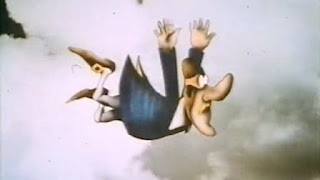
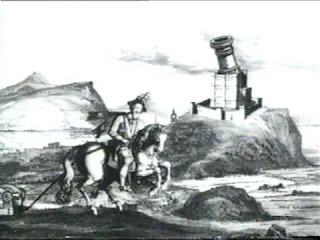
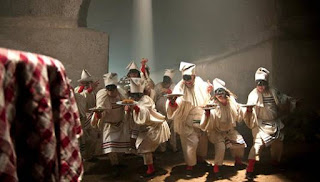
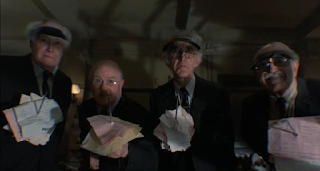
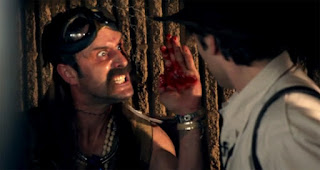




Post a Comment